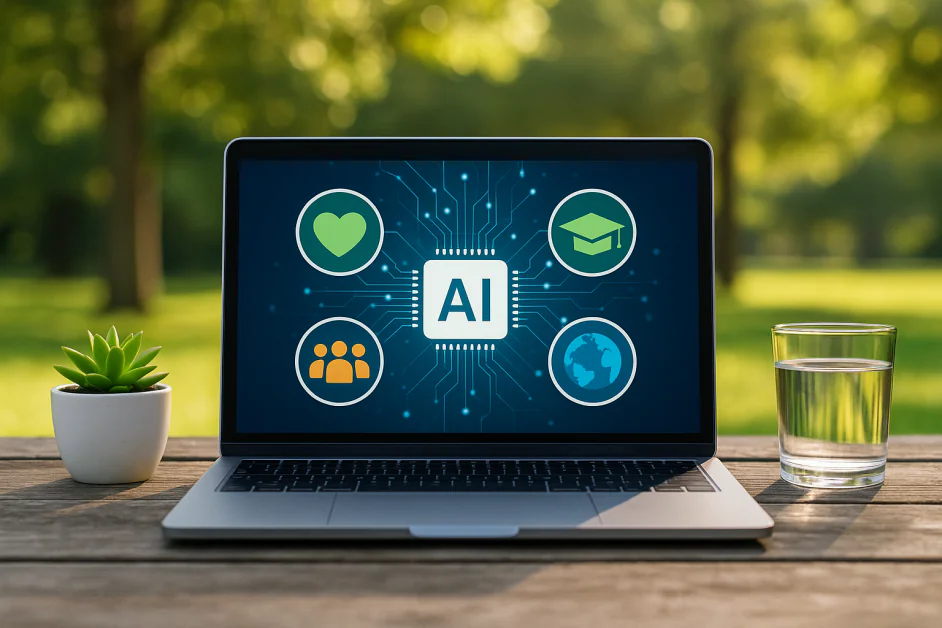Thought Leaders
From Isolation to Innovation – How Companies can Leverage AI for Social Good

The AI boom has been an anchor for businesses struggling to evolve and compete in an increasingly turbulent world. For many, its introduction has seen massive investment in AI projects across the globe, it has been deployed almost everywhere in departments within every industry and overhauled its operations, creating a more dynamic workplace for employees that supports rather than replaces them. McKinsey reported that 92% of companies plan to invest more in gen AI over the next 3 years, so clearly something has captured our collective imaginations.
To keep a little perspective MIT recently released a study revealing 95% of the AI projects implemented across the globe to date have failed to live up their original promise or deliver a return on the investment made. This is to be expected as we all get to grips with what AI can actually deliver and where best it should be deployed initially; as with every burgeoning technology we are early on the Hype Curve and we will become collectively smarter about where to use it most effectively in which sectors of a business, our economy and in our communities.
That’s not to say, though, that companies can’t take things a step further and go beyond their own remit to make a difference. Generative AI has proven to be a powerful tool that assists humans and engages with their ambitions. For those looking to scale, providing social value is becoming increasingly important to investors. Seeing a return that doesn’t just generate figures in a bank account not only stimulates growth but leaves a legacy to be enjoyed for generations to come. Here’s my breakdown for how company leaders can take charge and see the true benefits of AI.
1. Start With a Local Problem You Understand
It’s tempting to aim for grand projects like curing global diseases or solving climate change. Before you go all hyperscale, meaningful impact often starts small and that begins with your immediate community. Companies are better positioned to create lasting change when they focus on local issues they already understand, whether that’s education, environmental sustainability, or community health. The elderly in particular lack consistent social contact, so investing in initiatives to support their care and solve loneliness is a great step.
What you can do:
Conduct repeated workshops with cross-functional teams to identify one local challenge your company is uniquely positioned to address. For example, to address elderly loneliness, your employees can organise coffee meetups. Allocating a day per quarter for charity or volunteering is a great way to boost morale and make your company more attractive for prospective customers. Once identified keep meeting with the internal and external participants and stakeholders to maintain momentum and to effectively invoke the principle of continuous learning for everyone.
2. Build with Real Community Input, Not Assumptions
AI projects often fail to deliver impact because they are built on false assumptions about what communities need and how that need might be addressed Here it is essential to go Simon Sinek and ‘Start with Why’. Involving the actual beneficiaries from the start avoids this pitfall and leads to more effective, usable, scalable solutions. Let’s consider an often overlooked group – older adults or over 60’s., To build anything useful one must involve them in the conversation continuously through the evolution of you AI project not only to understand how you might actually help them but equally to understand how those older adults would like to engage with your offering. Positive engagement and user accessibility is critical to make any investment in technology successful and that investment in tech centred social initiatives properly delivered will certainly result in business growth that really helps a very undervalued part of our society
What you can do:
Before planning anything else define your ideal ‘customer’ profiles and then work through, interactive listening sessions with those customers as they are part of community groups, non-profits, and local leaders. Use their insights to define the problem statement and their ideal resolution, remembering that the resolution identified at the commencement of the project may be quite different as the project matures and evolves. This key step repeated through the project will reveal blind spots and barriers to adoption as well as key success features that internal teams overlook and ultimately ensure the project delivers on its mandate, the ‘customers’ are happy and keep returning whilst recommending the project to friends and family and your company is really making every
3. Use Open Data and Share Your Results
Social good projects don’t have to start from scratch. Many governments and non-profits publish open datasets that can be used to prototype solutions quickly. Equally important: companies should share back the data and models they develop, helping others build on their work. There is also enormous value in companies working together in the project input; in many cases collaborating on projects for social good really is a multiplier for the beneficiaries initially and ultimately for the business who committed resources, 1+1 really can equal 3 that that is great news.
What you can do:
Assign a team to explore open data portals (like data.gov or European Data Portal and the World Ethical Data Foundation). For your project, commit to releasing at least one tangible open-source tool or dataset. This encourages transparency and invites collaboration beyond your company walls. The dataset must be free of any confidential corporate or customer data, this is a present issue in most LLMs, so avoiding any potential breach should be top of your agenda; your Privacy Policy and IT Security Policies and Protocols should already maintain the ringfenced sensitive data within the secure data component of your company. Triple check before pressing ‘go’ but equally don’t give up if the security postures appear to limit the data you might leverage internally – always better to be safe than sorry!
4. Leverage Employees’ Personal Passions
Employees want to work for companies that contribute positively to society and understandably to their local communities – in fact the closer to home the initiatives the greater the engagement. According to the ONS, 92% of employees who work at a company with a strong sense of purpose would be more likely to recommend it to a job seeker. Tapping into this energy can unlock innovation that traditional top-down approaches miss.
What you can do:
Create an internal “AI for Social Good” ‘hackathon’ type challenge where employees, with engagement from their families pitch ideas for solutions, products or even services. Start small, continuously improve in controlled steps with small budgets for AI resources and ensure good technical mentoring. Winning ideas very often lead to pilot programs that eventually scale up to become products in their own right and we need to celebrate and encourage that daily.
5. Partner with Non-Profits and University Research Teams for Pilot Programs
Many non-profits have deep knowledge of social issues but lack technological resources. Companies and university research teams have technical expertise and research rigour but are limited in on-the-ground experience.
What you can do:
Select a non-profit partner aligned with your chosen issue. Offer them more than money. Offer your services by providing AI skills, cloud resources, or data analysis support. Start with a limited-scope pilot (3-6 months), measure impact, and iterate once you’ve had initial success.
6. Make Responsible AI the Default, Not an Afterthought
AI for social good can backfire if not designed responsibly, amplifying biases or creating unintended consequences. Building with responsibility from the beginning avoids reputational and operational risks.
What you can do:
Adopt simple but effective guardrails such as bias audits on datasets, use explainable AI techniques so outputs can be easily understood. You really should also implement transparent feedback loops where community partners can report concerns and new features or ideas (this is very much Business as Usual for most thriving companies; ignore it at your peril). Mozilla is an example of a company taking the initiative with their Common Voice project, making transparency the norm. In essence, responsible design should be a standard practice, not an optional extra. By following these essential practices, you can not only make your service offerings attractive, but consistent, reliable and effective too.
7. Turn Social Good Projects into Innovation Labs
Social good initiatives deployed responsibly and ethically can double as ‘incubator spaces’ for new AI techniques and even home grown LLM’s. Companies can use these projects to familiarise staff with AI, explore cutting-edge methods, or even test alternative business models without immediate commercial pressures whilst enjoying the benefits of a typical product development lifecycle process.
What you can do:
Once you have selected one or two seemingly viable initiatives, and the ethical and data privacy elements are in place and assured get the teams started. Check in on progress regularly without stifling the projects and be prepared to stop immediately if there is any risk of harm to the individual people involved, or the wider community.
8. Report Impact with Concrete Metrics
One of the fastest ways to lose credibility is to talk about “doing good” without proof. Companies should report tangible outcomes, not just intentions which is where partnerships with Academic Institutions as well as community groups and non-profits often assist greatly in getting to the numbers. Researchers, especially post grad students need to provide comprehensive data as a part of their projects to their supervising lecturers and professors and in my experience that really focuses everyone down onto the really tangible outcomes
What you can do:
Define clear impact metrics, and especially what success at each stage of the project will look like from the start e.g., tons of food saved, community group members reached with xx benefits attained at YY investment cost in time and money. Once the project completes, publish a concise report detailing both successes and failures and recommendations for how the project might continue or be improved. This transparency builds trust with employees, customers, and stakeholders and is essentially if we are to prevent our communities and citizens becoming AI ‘guinea pigs – we are talking about real humans that we need to value as individuals; we must not treat them as disposable test subjects in any way.
9. Avoid “One-Off” Initiatives
Many corporate social good programmes are one-time campaigns that fizzle out within a short period of time. Meaningful impact comes from integrating social responsibility into a core strategy, aligned with specific markets or wider long-term initiatives.
What you can do:
Add AI-for-social-good criteria to your R&D portfolio review. Allocate a fixed percentage (even 5%) of AI resources toward social impact projects annually. This ensures long-term commitment and learning. Be strategic with the resources you trial. The investment must provide a return even if it feels impossible. Without that assurance, you can potentially be wasting money on projects which don’t ultimately serve your company or customers.
Why This Approach Matters
Companies that genuinely integrate AI for social good programmes aren’t just adding a feel-good chapter to their annual report. They build value by strengthening community ties, attracting mission-driven talent, curating responsibly effective AI skills internally, and create positive brand differentiation in crowded markets.
In a world where the public is increasingly sceptical of corporate value washing, sustained impact speaks louder than promises.
This isn’t just about charity; it’s about smarter business with a meaningful legacy.












